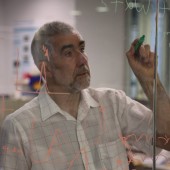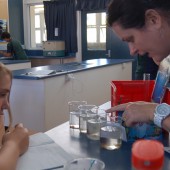Washington, D.C., Oct. 30, 2013 — The American Institute of Physics (AIP) has named a journalist and a children’s book author as winners of the 2013 AIP Science Communications Awards for their works on the discovery of the Higgs boson and a dog’s imaginary trip to the Moon.
Tom Siegfried will receive the prize in the science writing category for his essay “Nature’s Secrets Foretold,” published in Science News magazine. Jeffrey Bennett will receive the award in the writing for children category for his book Max Goes to the Moon.
The selection committees praised Siegfried’s article for its skillful and engaging writing, which made a complex topic accessible to a general audience, and Bennett’s book for its delightful blend of fact and fiction.
“Bennett’s imaginative storytelling and Siegfried’s elegant descriptions of complex concepts make these two pieces as engaging as they are informative,” said Catherine O’Riordan, AIP vice president for Physics Resources. “Their efforts provide readers with context for important discoveries and fundamental scientific concepts, and AIP is pleased to recognize their work.”
Each winner will receive a $3,000 check, an inscribed Windsor chair, and a certificate of recognition from AIP. The awards will be presented at the American Astronomical Society (AAS) 2014 winter meeting in National Harbor, Md.
Celebrating Math’s Power to Predict
For decades, physicists thought they knew why nature’s basic particles possess mass. There had to be a field — permeating all of space — that impeded changes in a particle’s motion, creating inertia, the hallmark of mass. Such a field, properly energized, would reveal itself by the appearance of a particle called the Higgs boson. Its discovery at the Large Hadron Collider was a landmark in physics history, but the implications went far beyond explaining the origin of mass.
In his essay “Nature’s Secrets Foretold,” published in Science News magazine, Siegfried seeks to provide a broader perspective for this recent discovery: first, that the Higgs field, by conferring mass on particles, made all the complexities of nature possible, from atoms and molecules to people and planets; and second, that the Higgs discovery was a validation of the idea that humans can use mathematical ingenuity to discern nature’s deepest secrets. Formulations developed by Peter Higgs and other scientists foresaw the existence of something that, in order to be proven, required the construction of a multibillion-dollar machine.
 Tom Siegfried is a freelance writer and editor who currently writes the Context blog at www.sciencenews.org. From 2007 to 2012 he was the editor in chief of Science News, and previously he was the science editor of The Dallas Morning News. In addition to Science News, his work has appeared in Science, Nature, Astronomy, New Scientist, and Smithsonian.He is the author of three books: The Bit and the Pendulum, (Wiley, 2000);Strange Matters (National Academy of Sciences’ Joseph Henry Press, 2002); and A Beautiful Math (2006, Joseph Henry Press).
Tom Siegfried is a freelance writer and editor who currently writes the Context blog at www.sciencenews.org. From 2007 to 2012 he was the editor in chief of Science News, and previously he was the science editor of The Dallas Morning News. In addition to Science News, his work has appeared in Science, Nature, Astronomy, New Scientist, and Smithsonian.He is the author of three books: The Bit and the Pendulum, (Wiley, 2000);Strange Matters (National Academy of Sciences’ Joseph Henry Press, 2002); and A Beautiful Math (2006, Joseph Henry Press).
Tom was born in Lakewood, Ohio, and grew up in nearby Avon. He earned an undergraduate degree from Texas Christian University with majors in journalism, chemistry and history, and has an MA with a major in journalism and a minor in physics from the University of Texas at Austin.
His awards include the American Geophysical Union’s Robert C. Cowen Award for Sustained Achievement in Science Journalism, the Science in Society Award from the National Association of Science Writers, the American Association for the Advancement of Science-Westinghouse Award, and the American Chemical Society’s James T. Grady-James H. Stack Award for Interpreting Chemistry for the Public. He is currently on the board of directors and serves as treasurer for the Council for the Advancement of Science Writing (CASW).
Moon’s Best Friend
 Max Goes to the Moon tells the story of a dog (Max) and a young girl who join in the first human trip to the Moon since the Apollo era. Like all of his books, said author Jeffrey Bennett, it is designed to provide education, through scientifically accurate content; perspective, by helping readers learn to see themselves and our planet in a new light; and inspiration, by encouraging children to dream of how they can help make the world a better place — and perhaps travel to space themselves someday.
Max Goes to the Moon tells the story of a dog (Max) and a young girl who join in the first human trip to the Moon since the Apollo era. Like all of his books, said author Jeffrey Bennett, it is designed to provide education, through scientifically accurate content; perspective, by helping readers learn to see themselves and our planet in a new light; and inspiration, by encouraging children to dream of how they can help make the world a better place — and perhaps travel to space themselves someday.
Max Goes to the Moon was read from orbit by astronaut Alvin Drew during the final mission of the Space Shuttle Discovery. It is now set for launch to the International Space Station, where it and Bennett’s four other children’s books (Max Goes to Mars, Max Goes to Jupiter, Max Goes to the Space Station, and The Wizard Who Saved the World) will be the first five books read in the new “Story Time From Space” program. Max Goes to the Moon is available in both English and Spanish (Max viaja a la luna).
The book, which the National Science Teachers Association has recommended for grades K-8, has been turned into a planetarium show for small- and mid-size planetariums. The show is available for the cost of duplication from Fiske Planetarium at the University of Colorado (fiske@colorado.edu). More information and a trailer can be found at: http://www.bigkidscience.com/planetariumshow.html
 Jeffrey Bennett holds a BA in biophysics from the University of California, San Diego, and an MS and PhD in astrophysics from the University of Colorado, Boulder. His extensive experience in research and education includes teaching at every level from preschool through graduate school, proposing and helping to develop the Voyage Scale Model Solar System on the National Mall in Washington, D.C., and serving two years as a visiting senior scientist at NASA Headquarters. He is the lead author of best-selling college textbooks in astronomy, astrobiology, mathematics, and statistics, and of several books for the general public including Math for Life (Big Kid Science, 2014), and the forthcoming What is Relativity? (Columbia University Press, 2014). His personal web site is www.jeffreybennett.com.
Jeffrey Bennett holds a BA in biophysics from the University of California, San Diego, and an MS and PhD in astrophysics from the University of Colorado, Boulder. His extensive experience in research and education includes teaching at every level from preschool through graduate school, proposing and helping to develop the Voyage Scale Model Solar System on the National Mall in Washington, D.C., and serving two years as a visiting senior scientist at NASA Headquarters. He is the lead author of best-selling college textbooks in astronomy, astrobiology, mathematics, and statistics, and of several books for the general public including Math for Life (Big Kid Science, 2014), and the forthcoming What is Relativity? (Columbia University Press, 2014). His personal web site is www.jeffreybennett.com.
About the AIP Science Communication Awards
The AIP Science Communication Awards aim to promote effective science communication in print and new media in order to improve the general public’s appreciation of physics, astronomy, and allied science fields. The awards are presented at venues that best highlight the science covered in the publications.
For more information, contact Jason Socrates Bardi (jbardi@aip.org) or visit the AIP website (http://www.aip.org/aip/writing/).


 Tom Siegfried is a freelance writer and editor who currently writes the Context blog at www.sciencenews.org. From 2007 to 2012 he was the editor in chief of Science News, and previously he was the science editor of The Dallas Morning News. In addition to Science News, his work has appeared in Science, Nature, Astronomy, New Scientist, and Smithsonian.He is the author of three books: The Bit and the Pendulum, (Wiley, 2000);Strange Matters (National Academy of Sciences’ Joseph Henry Press, 2002); and A Beautiful Math (2006, Joseph Henry Press).
Tom Siegfried is a freelance writer and editor who currently writes the Context blog at www.sciencenews.org. From 2007 to 2012 he was the editor in chief of Science News, and previously he was the science editor of The Dallas Morning News. In addition to Science News, his work has appeared in Science, Nature, Astronomy, New Scientist, and Smithsonian.He is the author of three books: The Bit and the Pendulum, (Wiley, 2000);Strange Matters (National Academy of Sciences’ Joseph Henry Press, 2002); and A Beautiful Math (2006, Joseph Henry Press). Max Goes to the Moon tells the story of a dog (Max) and a young girl who join in the first human trip to the Moon since the Apollo era. Like all of his books, said author Jeffrey Bennett, it is designed to provide education, through scientifically accurate content; perspective, by helping readers learn to see themselves and our planet in a new light; and inspiration, by encouraging children to dream of how they can help make the world a better place — and perhaps travel to space themselves someday.
Max Goes to the Moon tells the story of a dog (Max) and a young girl who join in the first human trip to the Moon since the Apollo era. Like all of his books, said author Jeffrey Bennett, it is designed to provide education, through scientifically accurate content; perspective, by helping readers learn to see themselves and our planet in a new light; and inspiration, by encouraging children to dream of how they can help make the world a better place — and perhaps travel to space themselves someday. Jeffrey Bennett holds a BA in biophysics from the University of California, San Diego, and an MS and PhD in astrophysics from the University of Colorado, Boulder. His extensive experience in research and education includes teaching at every level from preschool through graduate school, proposing and helping to develop the Voyage Scale Model Solar System on the National Mall in Washington, D.C., and serving two years as a visiting senior scientist at NASA Headquarters. He is the lead author of best-selling college textbooks in astronomy, astrobiology, mathematics, and statistics, and of several books for the general public including Math for Life (Big Kid Science, 2014), and the forthcoming What is Relativity? (Columbia University Press, 2014). His personal web site is
Jeffrey Bennett holds a BA in biophysics from the University of California, San Diego, and an MS and PhD in astrophysics from the University of Colorado, Boulder. His extensive experience in research and education includes teaching at every level from preschool through graduate school, proposing and helping to develop the Voyage Scale Model Solar System on the National Mall in Washington, D.C., and serving two years as a visiting senior scientist at NASA Headquarters. He is the lead author of best-selling college textbooks in astronomy, astrobiology, mathematics, and statistics, and of several books for the general public including Math for Life (Big Kid Science, 2014), and the forthcoming What is Relativity? (Columbia University Press, 2014). His personal web site is 






